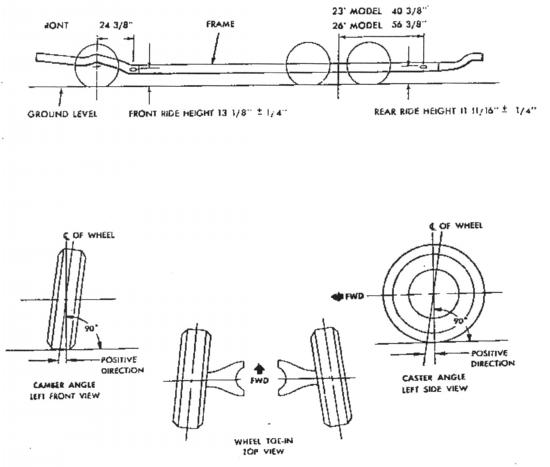
Wheel Alignment
Safe steering control with minimum tire wear, can be achieved
on the GMC coach when certain values are set for the planes angles
and radii of the front suspension and steering members. The terms
and their meanings are discussed as follows.
Camber angle:
Measured in degrees and is the angle that the wheels are angled
out at the top for positive camber or in at the top for negative
camber.
Caster angle:
Measured in degrees and is the amount that the knuckle support
pivot points are tilted toward the back of the coach at the top
for positive caster or toward the front of the coach in the case
of negative caster. The effect of positive caster is cause the
coach to steer in the direction that it goes. Positive caster
tends to steer down off of the crown of a road or in the direction
of a cross wind. Negative caster will tend to cause a coach to
steer up a crown or into a cross wind.
Toe-in:
The amount that the front of the wheels are closer together than
the rear of the wheels. Measured in inches on the GMC coach. Generally,
toe in is set to modify the effects of camber. This is because
a cambered wheel tends to steer in the direction that it is cambered.
Toe-in is set to compensate slightly in the direction opposite
to the direction the wheel tends to steer. Camber and caster both
have an effect on toe in therefore toe-in is the last setting
to be made when aligning the front suspension and steering system.
Built into the geometry of the front suspension of the GMC coach is the inclination of the knuckle support pivots. This is called the steering axis inclination. The pivots on the GMC are the upper and lower ball joints and the axis through the ball joints is inclined inward at the top. The pivot inclination angle is not the same angle as camber, but, it changes with camber changes. The function of pivot inclination is to cause the coach to tend to steer in a straight line regardless of outside forces such as crowned roads and cross winds. As the spindle is moved through its steering from left to right turns, the spindle rises and falls. This action forces the coach to rise and fall since the tires are in contact with the ground and the forces are being transferred to the coach through the suspension. The coach will rise at the extreme right turn and come to its lowest point at the straight ahead position and again rise for an extreme left turn. The weight of the coach will tend to cause the wheels to come to the straight ahead position, which is the lowest position of the coach itself.
Recommended Alignment Settings
Caster + 1
Camber L.H. 0
Camber R.H. - 1/4
Toe In/Out 0 (Toe In)
Factory Alignment Recommendations
Caster +2
Camber L.H. +3/4
Camber R.H. + 1/2
Toe In/Out - 1/8"(Toe Out)
